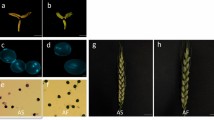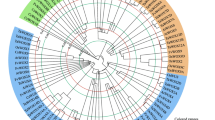Abstract
Plant seed development and germination are under strict temporal and spatial regulation, and transcription factors play important roles in this regulation. In the present study we identified an EST expressed specifically in the developing soybean seeds. The full length of the gene was obtained through further RACE analysis and the gene was named GmSGR. Sequence analysis revealed that this gene belonged to the AP2/ERF transcription factor family. Its AP2 domain had the highest similarity with that of the A-3 member AtABI4 of DREB subgroup in the AP2/ERF family in Arabidopsis. GmSGR did not exhibit transcriptional activation activity in the yeast assay system. GmSGR was overexpressed in Arabidopsis and the germination rates of the transgenic seeds were significantly higher than that of the wild type seeds under higher concentrations of ABA and glucose respectively. However, the germination rates of the transgenic seeds were lower than that of control under salt stress. The expression of AtEm6 and AtRD29B was higher in the seedlings of the transgenic plants than that in the wild-type seedlings. These results suggest that GmSGR may confer reduced ABA sensitivity and enhanced salt sensitivity to the transgenic seeds through regulating the expression of AtEm6 and AtRD29B genes.
Similar content being viewed by others
References
Koornneef M, Bentsink L, Hilhorst H. Seed dormancy and germination. Curr Opin Plant Biol, 2002, 5: 33–36,11788305, 10.1016/S1369-5266(01)00219-9, 1:CAS:528:DC%2BD38Xitlejtw%3D%3D
Kucera B, Cohn M A, Leubner-Metzger G. Plant hormone interactions during seed dormancy release and germination. Seed Sci Res, 2005, 15: 281–307,10.1079/SSR2005218, 1:CAS:528:DC%2BD28XhsFGrtr0%3D
Jacobsen J V, Pearce D W, Poole A T, et al. Abscisic acid, phaseic acid and gibberellin contents associated with dormancy and germination in barley. Physiol Plant, 2002, 115: 428–441, 12081536, 10.1034/j.1399-3054.2002.1150313.x, 1:CAS:528:DC%2BD38XlsVGitLo%3D
Ali-Rachedi S, Bouinot D, Wagner M H, et al. Changes in endogenous abscisic acid levels during dormancy release and maintenance of mature seeds: Studies with the Cape Verde Islands ecotype, the dormant model of Arabidopsis thaliana. Planta, 2004, 219: 479–488, 15060827, 10.1007/s00425-004-1251-4, 1:CAS:528:DC%2BD2cXlsVCktbg%3D
Finkelstein R R. Mutations at two new Arabidopsis ABA response loci are similar to the abi3 mutations. Plant J, 1994, 5: 765–771, 10.1046/j.1365-313X.1994.5060765.x
Nambara E, Naito S, McCourt P. A mutant of Arabidopsis which is defective in seed development and storage protein accumulation is a new abi3 allele. Plant J, 1992, 2: 435–441, 10.1111/j.1365-313X.1992.00435.x, 1:CAS:528:DyaK38XlsVOgsr4%3D
Giraudat J, Hauge B M, Valon C, et al. Isolation of the Arabidopsis ABI3 gene by positional cloning. Plant Cell, 1992, 4: 1251–1261,1359917, 10.1105/tpc.4.10.1251, 1:CAS:528:DyaK3sXit1KqtbY%3D
Finkelstein R R, Wang M L, Lynch T J, et al. The Arabidopsis abscisic acid response locus ABI4 encodes an APETALA 2 domain protein. Plant Cell, 1998, 10: 1043–1054, 9634591, 10.1105/tpc.10.6.1043, 1:CAS:528:DyaK1cXktl2gt7Y%3D
Arenas-Huertero F, Arroyo A, Zhou L, et al. Analysis of Arabidopsis glucose insensitive mutants, gin5 and gin6, reveals a central role of the plant hormone ABA in the regulation of plant vegetative development by sugar. Genes Dev, 2000, 14: 2085–2096, 10950871, 1:CAS:528:DC%2BD3cXmtFShu7k%3D
Huijser C, Kortstee A, Pego J, et al. The Arabidopsis SUCROSE UNCOUPLED-6 gene is identical to ABSCISIC ACID INSENSITIVE-4: Involvement of abscisic acid in sugar responses. Plant J, 2000, 23:577–585, 10972884, 10.1046/j.1365-313x.2000.00822.x, 1:CAS:528:DC%2BD3cXntFOiu7s%3D
Laby R J, Kincaid M S, Kim D, et al. The Arabidopsis sugar-insensitive mutants sis4 and sis5 are defective in abscisic acid synthesis and response. Plant J, 2000, 23: 587–596, 10972885, 10.1046/j.1365-313x.2000.00833.x, 1:CAS:528:DC%2BD3cXntFOiu7g%3D
Rook F, Corke F, Card R, et al. Impaired sucrose-induction mutants reveal the modulation of sugar-induced starch biosynthetic gene expression by abscisic acid signalling. Plant J, 2001, 26: 421–433, 11439129, 10.1046/j.1365-313X.2001.2641043.x, 1:CAS:528:DC%2BD3MXlsVynt7c%3D
Niu X, Helentjaris T, Bate N J. Maize ABI4 binds coupling element1 in abscisic acid and sugar response genes. Plant Cell, 2002, 14:2565–2575, 12368505, 10.1105/tpc.003400, 1:CAS:528:DC%2BD38XotFelsLY%3D
Peng J, Harberd N P. The role of GA-mediated signalling in the control of seed germination. Curr Opin Plant Biol, 2002, 5: 376–381,12183174, 10.1016/S1369-5266(02)00279-0, 1:CAS:528:DC%2BD38XmtlGjt7k%3D
Steber C M, Cooney S E, McCourt P. Isolation of the GA-response mutant sly1 as a suppressor of ABI1-1 in Arabidopsis thaliana. Genetics, 1998, 149: 509–521, 9611170, 1:CAS:528:DyaK1cXks1ehs7w%3D
Griffiths J, Murase K, Rieu I, et al. Genetic characterization and functional analysis of the GID1 gibberellin receptors in Arabidopsis. Plant Cell, 2006, 18: 3399–3414,17194763, 10.1105/tpc.106.047415, 1:CAS:528:DC%2BD2sXhvVKrur8%3D
Tyler L, Thomas S G, Hu J, et al. Della proteins and gibberellin-regulated seed germination and floral development in Arabidopsis. Plant Physiol, 2004, 135: 1008–1019,15173565, 10.1104/pp.104.039578, 1:CAS:528:DC%2BD2cXltlKisrc%3D
Jacobsen S E, Olszewski N E. Mutations at the SPINDLY locus of Arabidopsis alter gibberellin signal transduction. Plant Cell, 1993, 5:887–896, 8400871, 10.1105/tpc.5.8.887, 1:CAS:528:DyaK2cXht12lt7o%3D
Dekkers B J, Schuurmans J A, Smeekens S C. Glucose delays seed germination in Arabidopsis thaliana. Planta, 2004, 218: 579–588,14648119, 10.1007/s00425-003-1154-9, 1:CAS:528:DC%2BD2cXhtFGjtb0%3D
Price J, Li T C, Kang S G, et al. Mechanisms of glucose signaling during germination of Arabidopsis. Plant Physiol, 2003, 132: 1424–1438,12857824, 10.1104/pp.103.020347, 1:CAS:528:DC%2BD3sXlsFGhur4%3D
Yuan K, Wysocka-Diller J. Phytohormone signaling pathways interact with sugars during seed germination and seedling development. J Exp Bot, 2006, 57: 3359–3367,16916886, 10.1093/jxb/erl096, 1:CAS:528:DC%2BD28Xps1ygtLw%3D
Jofuku K D, den Boer B G, Van Montagu M, et al. Control of Arabidopsis flower and seed development by the homeotic gene APETALA2. Plant Cell, 1994, 6: 1211–1225, 7919989, 10.1105/tpc.6.9.1211, 1:CAS:528:DyaK2MXpsFOjsA%3D%3D
Sakuma Y, Liu Q, Dubouzet J G, et al. DNA-binding specificity of the ERF/AP2 domain of Arabidopsis DREBs, transcription factors involved in dehydration-and cold-inducible gene expression. Biochem Biophys Res Commun, 2002, 290: 998–1009, 11798174, 10.1006/bbrc.2001.6299, 1:CAS:528:DC%2BD38XksVyquw%3D%3D
Liu Q, Kasuga M, Sakuma Y, et al. Two transcription factors, DREB1 and DREB2, with an EREBP/AP2 DNA binding domain separate two cellular signal transduction pathways in drought-and low-temperature-responsive gene expression, respectively, in Arabidopsis. Plant Cell, 1998, 10: 1391–1406, 9707537, 10.1105/tpc.10.8.1391, 1:CAS:528:DyaK1cXls1SisLs%3D
Pandey G K, Grant J J, Cheong Y H, et al. ABR1, an APETALA2-domain transcription factor that functions as a repressor of ABA response in Arabidopsis. Plant Physiol, 2005, 139: 1185–1193, 16227468, 10.1104/pp.105.066324, 1:CAS:528:DC%2BD2MXht1Ogu7%2FN
Zhang J S, Zhou J M, Zhang C, et al. Differential gene expression in a salt-tolerance rice mutant and its parental variety. Sci China Ser C-Life Sci (in Chinese), 1996, 39: 310–319
Gosti F, Beaudoin N, Serizet C, et al. ABI1 protein phosphatase 2C is a negative regulator of abscisic acid signaling. Plant Cell, 1999, 11:897–1910,10.1105/tpc.11.10.1897
Li X P, Tian A G, Luo G Z, et al. Soybean DRE-binding transcription factors that are responsive to abiotic stresses. Theor Appl Genet, 2005, 110: 1355–1362, 15841365, 10.1007/s00122-004-1867-6, 1:CAS:528:DC%2BD2MXkvFSru78%3D
Chen M, Wang Q Y, Cheng X G, et al. GmDREB2, a soybean DRE-binding transcription factor, conferred drought and high-salt tolerance in transgenic plants. Biochem Biophys Res Commun, 2007, 353: 299–305, 17178106, 10.1016/j.bbrc.2006.12.027, 1:CAS:528:DC%2BD2sXhvVSkuw%3D%3D
Lee S, Cheng H, King K E, et al. Gibberellin regulates Arabidopsis seed germination via RGL2, a GAI/RGA-like gene whose expression is up-regulated following imbibition. Genes Dev, 2002, 16: 646–658, 11877383, 10.1101/gad.969002, 1:CAS:528:DC%2BD38XitVWltbY%3D
Soderman E M, Brocard I M, Lynch T J, et al. Regulation and function of the Arabidopsis ABA-insensitive4 gene in seed and abscisic acid response signaling networks. Plant Physiol, 2000, 124: 1752–1765,11115891, 10.1104/pp.124.4.1752, 1:CAS:528:DC%2BD3MXitVWrsQ%3D%3D
Gaubier P, Raynal M, Hull G, et al. Two different Em-like genes are expressed in Arabidopsis thaliana seeds during maturation. Mol Gen Genet, 1993, 238: 409–418,8492809, 10.1007/BF00292000, 1:CAS:528:DyaK3sXlsFeisr4%3D
Hughes D W, Galau G A. Temporally modular gene expression during cotyledon development. Genes Dev, 1989, 3: 358–369, 2721959, 10.1101/gad.3.3.358, 1:CAS:528:DyaL1MXksFChtL8%3D
Swire-Clark G A, Marcotte W R. The wheat LEA protein Em functions as an osmoprotective molecule in Saccharomyces cerevisiae. Plant Mol Biol, 1999, 39: 117–128,10080714, 10.1023/A:1006106906345, 1:CAS:528:DyaK1MXhvVynu7w%3D
Vicient C M, Hull G, Guilleminot J, et al. Differential expression of the Arabidopsis genes coding for Em-like proteins. J Exp Bot, 2000, 51: 1211–1220,10937696, 10.1093/jexbot/51.348.1211, 1:CAS:528:DC%2BD3cXlsVyjt7c%3D
Manfre A J, Lanni L M, Marcotte W R. The Arabidopsis group 1 LATE EMBRYOGENESIS ABUNDANT protein ATEM6 is required for normal seed development. Plant Physiol, 2006, 140: 140–149,16361514, 10.1104/pp.105.072967, 1:CAS:528:DC%2BD28XhtVCgsb8%3D
Yamaguchi-Shinozaki K, Shinozaki K. A novel cis-acting element in an Arabidopsis gene is involved in responsiveness to drought, low-temperature, or high-salt stress. Plant Cell, 1994, 6: 251–264, 8148648, 10.1105/tpc.6.2.251, 1:CAS:528:DyaK2cXlslWqu70%3D
Nakashima K, Fujita Y, Katsura K, et al. Transcriptional regulation of ABI3-and ABA-responsive genes including RD29B and RD29A in seeds, germinating embryos, and seedlings of Arabidopsis. Plant Mol Biol, 2006, 60: 51–68, 16463099, 10.1007/s11103-005-2418-5, 1:CAS:528:DC%2BD28XhtFyntrw%3D
Author information
Authors and Affiliations
Corresponding author
Additional information
Supported by the National Natural Science Foundation of China (Grant No. 30490254) and the Major Basic Research Program of China (Grant Nos. 2004CB117200 and 2002CB111303)
Rights and permissions
About this article
Cite this article
Wang, C., Wang, H., Zhang, J. et al. A seed-specific AP2-domain transcription factor from soybean plays a certain role in regulation of seed germination. SCI CHINA SER C 51, 336–345 (2008). https://doi.org/10.1007/s11427-008-0044-6
Received:
Accepted:
Published:
Issue Date:
DOI: https://doi.org/10.1007/s11427-008-0044-6




